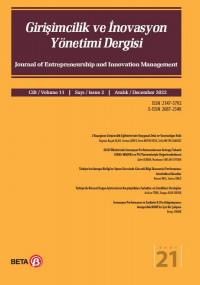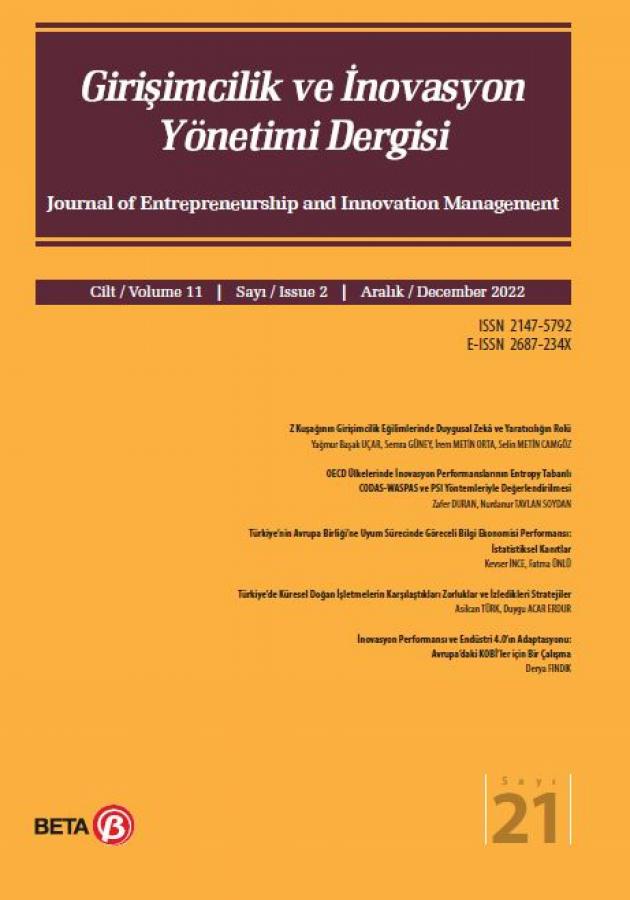6 (1), 2017
From Editor
Dear Readers,
On behalf of the Editorial Board and my co-editors of the Journal of Entrepreneurship and Innovation Management (http://www.betadergi.com/jeim/), I happy to present the Volume 6, Issue 1 of this journal. The journal established in 2012 has now published 10 issues; two issues in a year. The journal is now being indexed in Directory of Open Access Journals (http://oaji.net/) and ULAKBIM Turkish Journal Indexed and Google Scholar.
Average download per article is increasing after each issue and currently on an average there are 78 downloads per paper. All these are promising signs in the way of improving the Journal’s visibility and impact. We reached this stage through the constant support of Board Members, readers, authors and reviewers.
One of the main objectives of this journal is to encourage publication from different streams of research that helps to enrich further the discussions on innovation, entrepreneurship, university industry collaboration and small business.
In this 10th issue we have seven research papers from different topics of the innovation, entrepreneurship and management. We hope this issue will also provide useful information both researchers, professionals as well as policy makers.
Finally, I like to remind you that you can access all our past and current issues with no charge. I strongly recommend you to read our publications and I believe this will be helpful for your current research and professional business. Last but not least, I like to invite each of you to register our database (http://www.betadergi.com/jeim/) as a reviewer and author. We need your contribution and your presence will be very helpful for the future of the journal.
We are hoping to that this issue will help many of us to extend our understanding of the covered topics and also will be based of further research papers. Wish you a nice summer break.
Best Regards
Prof. Dr. Cevahir UZKURT
Editor-in Chief
Deniz Kantur
Embeddedness in Social Entrepreneurship: The Role of Geographic Diffusion and Cultural Values While there is still debate in the literature regarding the definition of social entrepreneurship, this paper attempts to understand the role of cultural values in social entrepreneurship with different levels of geographic diffusion and embeddedness. With this aim, finalist social entrepreneurship projects of two culturally different award platforms are content analyzed. Results show that, embeddedness changes with different levels of geographic diffusion and cultural values stand-out with increased embeddedness. Moreover, in collectivist cultures, others-related values are dominant in social entrepreneurship. Overall, it is suggested that a single definition for social entrepreneurship is hard to achieve and propositions are developed suggesting that embeddedness increase the dominance of cultural values in social entrepreneurship and others-related values will be common in collectivist cultures.
Keywords: Social Entrepreneurship, Embeddedness, Geographic Diffusion, Cultural Values, Content Analysis
[PDF]
An Investigation on The Planned Behaviour Theory of The Students’ Entrepreneurial Intentions: A Research on Higher Vocational School’s (Short Cycle) Students Studying in Civil Aviation ProgrammesNowadays, entrepreneurs are regarded as the main actors of economic growth and development. Country’s entrepreneurship potential is claimed to determine its power of to compete, create innovation and capture to world market. For this reason, all the developed and developing countries try to restructure their economies and infrastructures according to this understanding and take care of new generations to transform them from being an employee to entrepreneur by promoting entrepreneurship activity. The aim of the study is to evaluate students’ aspect of entrepreneurship who is potential employees of aviation industry that have intense competition and entrance barrier. The method of this study is to apply a questionnaire to higher vocational school’s students (short cycle) studying in civil aviation programmes in Turkey in order to evaluate hypotheses that have been determined. According to the findings obtained from the application, it has been discussed that if the entrepreneurship effort in the aviation sector will be limited to main players / businesses such as "airlines, ground services, etc." or not. The study ends with the section containing the results and recommendations.
Keywords: Entrepreneurial Intentions, Theory of Planned Behaviour, Civil Aviation
[PDF]
Facilitation of Innovation as Public Policy: An Example of University-Industry-Government Collaboration on the Triple Helix Model The investment on knowledge production with a view to creating a competitive, innovative and development based system for the economic development of countries manifests itself as the most fundamental and highest in return among all investments. However, the facilitation of innovation is only possible when universities as knowledge producing institutions and industry as the structure that utilizes knowledge and transforms it into products ensure an effective co-operation. In this study, the EHIS LAB (HVAC-R Accredited Test And Analysis Laboratory) Project supported by the İzmir Development Agency is examined within the scope of the Triple Helix Model (Etzkowitz, Leydersdorff, 2008) which explains the university - industry- government collaboration. This study will study the taxonomy of EHİS LAB in consideration of the Triple Helix Model discuss the participation of each actor to the project in the scope of the above mentioned necessities. The main argument of the discussion is to put forward the combining role and function of the development agencies as institutions that represent the government and to be able to offer suggestions related to regional and national institutions and processes in order for the Triple Helix Model to be utilized efficiently.
Keywords: University-Industry-Government Collaboration, Triple Helix Model, Innovation, Governance
[PDF]
The Mediator Effect of Intrinsic Motivation on the Relationship between Individual Innovativeness and Employee’s Innovative Behavior: The Case of Surgeons in TurkeyThe study aims to investigate the effect of the individual innovativeness behavior, which may be the precursor of employees' behaviors towards innovation, on the employees’ innovative behavior and the mediating role of the intrinsic motivation on this effect. According to the results of the survey which 161 surgeons working in public and private hospitals in Turkey participated in, the relationship between three sub-dimensions (resistance to change, opinion leadership and openness to experience) and the employees’ innovative behavior was determined. Moreover, there was also a significantly positive correlation between intrinsic motivation and openness to experience. Furthermore, one of the emerging results is that the partial intermediary role of the intrinsic motivation has an influence in the effect of the openness to experience, which is one of the sub-dimensions of individual innovativeness behavior on the employees’ innovative behavior.
Keywords: Individual Innovativeness, Employee’s Innovative Behaviour, Intrinsic Motivation
[PDF]
The Mediator Effect of Intrinsic Motivation on the Relationship between Individual Innovativeness and Employee’s Innovative Behavior: The Case of Surgeons in TurkeyThe study aims to investigate the effect of the individual innovativeness behavior, which may be the precursor of employees' behaviors towards innovation, on the employees’ innovative behavior and the mediating role of the intrinsic motivation on this effect. According to the results of the survey which 161 surgeons working in public and private hospitals in Turkey participated in, the relationship between three sub-dimensions (resistance to change, opinion leadership and openness to experience) and the employees’ innovative behavior was determined. Moreover, there was also a significantly positive correlation between intrinsic motivation and openness to experience. Furthermore, one of the emerging results is that the partial intermediary role of the intrinsic motivation has an influence in the effect of the openness to experience, which is one of the sub-dimensions of individual innovativeness behavior on the employees’ innovative behavior.
Keywords: Individual Innovativeness, Employee’s Innovative Behaviour, Intrinsic Motivation
[PDF]
The Mediation Role of Human Resource Management Capabilities in Relationship with Resource Based View, Core Competence and Innovation The importance of organizational resources and capabilities are realized by business practitioners and researchers as they support firm performance and competitive advantage. However, what exactly core competence is not clearly understood since terms such as resource, capability and competence are used interchangeably by researchers. From this point forth, this article provides a framework for separating organization's core competencies from resource and capability. In the first part of the research the relations and interactions among resource, capability and competence is explained. In the second part core competence concept is described and three empirical determiners such as uniqueness, inimitability and extendibility is proposed to discriminate core competence from resources and competences. The relationship between innovation and core competence and past researches in the related literature is presented in the third part. After the role of human resources management capability is investigated in fourth part, the paper is completed by evaluation of the research findings, the limitation of the research and recommendations.
Keywords: resources1, competences1, core competence1, innovation1, human resource management capability5
[PDF]
ENVIRONMENTAL UNCERTAINTY AND THE EFFECTS OF THEORY X AND THEORY Y LEADERSHIP STYLES ON AMBIDEXTROUS INNOVATIONThis paper explores leadership-innovation ambidextrous relationships from the perspective of McGregor’s Theory X and Y, when faced with environmental uncertainty. Ambidexterity is an umbrella term for explorative and exploitive innovation. Data was collected via a pencil and paper survey. General findings of the study indicate that regardless of environmental uncertainty, Theory Y attitudes prevailed. Support emerged for the assumption that perceived environmental uncertainty results in a greater tendency to exhibit Theory X attitude among Theory X managers and owners. Similar results were observed for Theory Y managers and owners under the same circumstances. The central point being that their Theory Y point of view, not their attitude, still holds, and that change in attitude is due to the fear to “losing everything.” Although studied broadly, the literature on leadership and innovation reveals a complex and inconsistent findings. For that, we believe that this paper makes an important managerial contribution.
Keywords: Theory X and Theory Y, SMEs, Innovations, Uncertainty, Ambidextrous Innovations.
[PDF]


